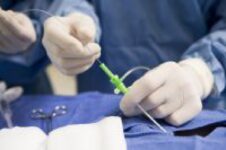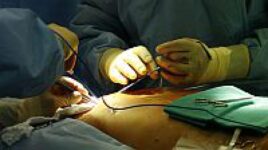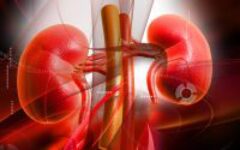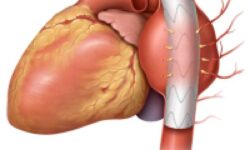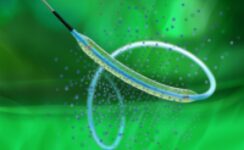Original title: Association of the Recovery of Objective Abnormal CerebralPerfusion with Neurocognitive Improvement after CarotidRevascularization. Reference: Ching-Chang Huanget al. J Am CollCardiol 2013. Article in press. Cognitive impairment was observed in patients with severe asymptomatic carotid injury but a possible explanation for this is hyper-perfusion. Intuitively restored flow may improve neurocognitive capacity but so far studies have been…
Result of bifurcated devices to protect the internal iliac in aorto-iliac aneurysms
Original title: Endovascular Treatment of Aorto-iliac Aneurysms: Four-year Results of Iliac Branch Endograft. Reference: G. Pratesi et al. Eur J Vasc Endovasc Surg. 2013 Jun;45(6):607-9. Iliac bifurcated devices have proven to be effective in treating common iliac aneurysms but the findings are based on small series, generally from a sole center experience. This multicenter registry included 85 patients…
Endovascular or surgical popliteal aneurysms exclusion – both with good results but for different patients.
Original title: A Multicentric Experience with Open Surgical Repair and Endovascular Exclusion of Popliteal Artery Aneurysms. Reference: R. Pulli et al. European Journal of Vascular and Endovascular Surgery, Volume 45, Issue 4, Pages 357-363. Complications of a popliteal aneurysm may cause rupture, distal embolization or thrombosis with a risk of any of them affecting the lower limb.…
Angioplasty to common femoral artery begins to emerge as an alternative to surgery
Original title: Acute and Medium-Term Outcomes of Endovascular Therapy of Obstructive Disease of Diverse Etiology of the Common Femoral Artery. Reference: Philip B. Dattilo et al. Catheterization and Cardiovascular Interventions 81:1013–1022 (2013). Surgical endarterectomy is established as the gold standard for treating injuries to common femoral artery since angioplasty presents some difficulties due to the risk of compromising…
Self-expandable stenting with jailed deep femoral artery (DFA) for proximal superficial femoral artery (SFA) lesions is safe
Original title: Deployment of Self-Expandable Stents for Complex Proximal Superficial Femoral Artery Lesions Involving the Femoral Bifurcation With Or Without Jailed Deep Femoral Artery. Reference: Masahiro Yamawaki et al. Catheterization and Cardiovascular Interventions 81:1031–1041 (2013). The endovascular management of chronic total occlusions of the lower extremities has seen great progress over the past years; however, specific segments require…
Chimney technique for type B aortic dissection
Original title: The Single-centre Experience of the Supra-arch Chimney Technique in Endovascular Repair of Type B Aortic Dissections. Reference: Y. Zhu et al. European Journal of Vascular and Endovascular Surgery Volume 45 Issue 6 June/2013. Endovascular repair of type B aortic dissection (TEVAR) involving the arch, requires special techniques to preserve supra aortic vessels as fenestrated prostheses or…
Renal Denervation: All Published Literature Available so far
Original title: Effectiveness of Renal Denervation Therapy for Resistant Hypertension: A Systematic Review and Meta-Analysis. Reference: Mark I. Davis et al. J Am Coll Cardiol 2013. Article in press. Resistant Hypertension is the impossibility to control blood pressure despite the use of 3 or more different types of drugs, including diuretics. For most studies, at least 10 to…
Safety and superior effectiveness over two years in femoropopliteal region with drug-eluting stents
Original title: Sustained safety and effectiveness of paclitaxel-eluting stents for femoropopliteal lesions: two-year follow-up from the Zilver PTX randomized and single-arm clinical studies. Reference: Michael D. Dake et al. J Am Coll Cardiol 2013. Article in press. Studies with long-term monitoring showed mainly the limited permeability of balloon angioplasty, especially over challenging injuries such as total occlusions or…
Stanford Type A Aortic Dissection Can Be Treated with Endoprosthesis
Original title: Endovascular Repair of Ascending Aortic Dissection. A Novel Treatment Option for Patients Judged Unfit for Direct Surgical Repair. Reference: Qingsheng Lu, et al. J Am Coll Cardiol 2013;61:1917–24. The dissecting aneurysm Type A represents 60% or aortic dissections and a real challenge as regards both therapeutics and the adequate moment to perform it, due to the…
Bivalirudin reduces bleeding complications in carotid angioplasty
Original title: Hemorrhagic and ischemic outcomes after bivalirudin versus unfractionated heparin during carotid artery stenting: A propensity score analysis from the NCDR. Reference: Wayangankar SA et al. Circ Cardiovasc Interv. 2013;Epub ahead of print. Bivalirudin is a direct thrombin inhibitor that has shown similar efficacy with a better safety profile in the context of coronary angioplasty. However, its…
More evidence for drug eluting balloons in the femoropopliteal region
Original title: 2-Year Results of Paclitaxel-Eluting Balloons for Femoropopliteal Artery Disease. Evidence From a Multicenter Registry. Reference: Antonio Micari et al. J Am Coll Cardiol Intv 2013;6:282–9. Paclitaxel-eluting balloons appear safe and effective for treating atherosclerotic lesions in the femoropopliteal region, leaving the stent only as a rescue strategy against a suboptimal outcome. However, the vast majority of…



